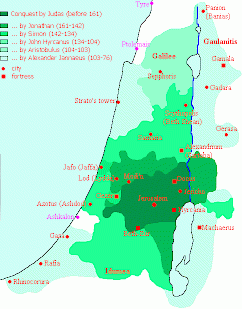Hasmonaeans
Q496922Hasmonaeans: Jewish dynasty, ruled Judaea between 152 and 37 BCE, first as high priests, later as kings.

Originally, the Hasmonaeans were a Jewish priestly family from Mode'in, who claimed descent from a man named Hašmôn, who was the father or great-grandfather of the first known member of the family, Mattathias.
Since 167 BCE, Mattathias organized the armed resistance against the Seleucid king Antiochus IV Epiphanes (175-164), who had started a persecution of the Jews (more). In 165, his son Judas the Maccabaean (perhaps "battle hammer") was able to reconquer the Temple of Jerusalem and restore the cult, an event that is still celebrated by the Jews at the annual Hanuka festival. Antiochus' successor Antiochus V Eupator (164-162) appointed a new high priest, Alcimus. Judas and - after his death in 161 - his brother Jonathan went on to conquer neighboring territories.
In 152, the Seleucid pretender Alexander Balas appointed Jonathan as high priest. Actually, this was not allowed, because the new official did not belong to the Zadokite family, but neither had Alcimus been, so the appointment was accepted. (It has been argued, however, that this was the incident that caused the 'teacher of righteousness' to leave Jerusalem and organize the sect of Qumran.) The struggle against the Seleucid kings continued in these years, and it lasted until 142 before the war aims -end of the garrison at Jerusalem and end of the tribute- were reached.
In the following year, 141, the people elected Simon, a brother of Jonathan and Judas, as high priest. He added several towns to the country. This policy was continued by his son John Hyrcanus, who conquered Samaria, Idumea and gave his country a harbor (Azotus).
Numismatic evidence shows that the royal title was first accepted by Alexander Jannaeus, who conquered Galilee. The royal title, however, traditionally belonged to the family of David, whose descendants were still alive. There was an open conflict between the Hasmonaean dynasty and the Pharisees, which lasted from 94-86. When Alexander was succeeded by his wife Alexandra, Pharisees were accepted in official functions, which meant the end of this quarrel.
After Alexandra's death, two brothers started a civil war: Hyrcanus, the oldest, and Aristobulus, the most energetical. At first, Aristobulus became king, but the Roman general Pompey was convinced by the arguments of Hyrcanus' servant Antipater that Hyrcanus was the rightful king. He took Jerusalem in 63, which was the beginning of the Roman period in the Jewish history.
In 40, the Parthians invaded the Roman empire and captured Hyrcanus, whose ears were cut off. This made him unsuited to be king or high priest. For a brief period, Antigonus, the son of Aristobulus, was recognized as king of the Jews, but he was dethroned by the son of Antipater, king Herod the Great, who strengthened his claim to the throne by marrying a Hasmonaean princess.
|
|
|
|
|
|
|
|
|
|
|
|
|
|
|
|
|
|
|
|
|
|
|
|
|
|
|
|
|
|
|
|
|
|
|
|
|
|
|